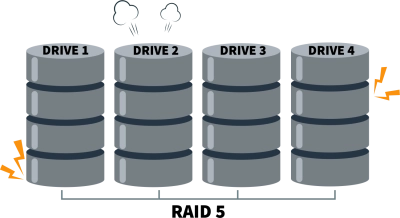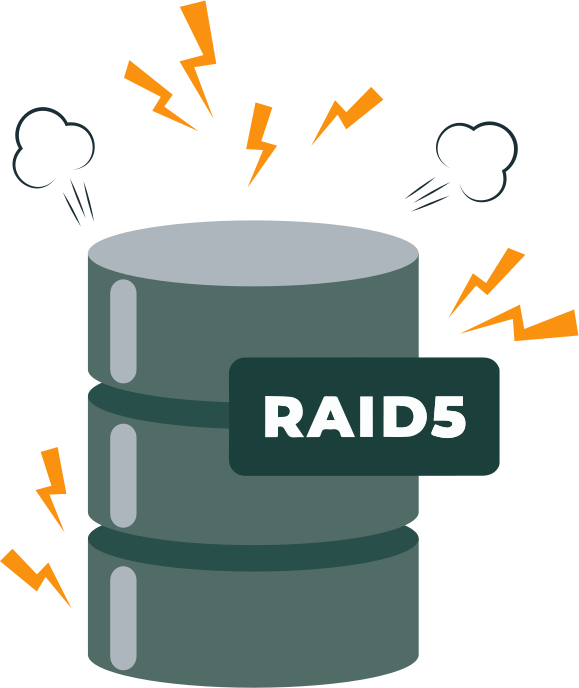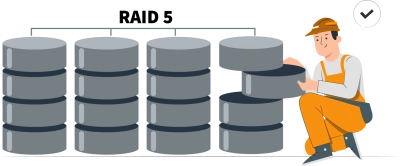How many disks can fail in RAID 5?

RAID arrays are unique and utilize different data storage and recovery techniques. Home users, small businesses, and IT professionals use different types of RAID arrays for specific purposes. However, RAID 5 is considered a more flexible option for most people, this is because it supports data stripping with parity.
Encountering disk failures in RAID 5 has minimal effects – provided it’s just one disk that fails at a time. RAID 5 requires at least three (3) hard drives for you to set it up; you can’t lose your files in a RAID 5 array if it’s just one of your drives that went bad. But then, if it's two, you may rely on the mercy of a professional RAID recovery software.
This article explains all you should know about RAID 5 array and how many disk failures per time could lead to fatal data loss.
What is RAID 5?

RAID 5 is a modern RAID level meant to simplify the complexities of RAID 6. It supports data stripping with distributed parity, which makes it capable of withstanding a single failed disk at a time. Setting up a RAID 5 is much simpler and costs less than setting up a RAID 6. Data stripping in RAID 5 means new data is stripped and distributed across member disks in the array.
The essence of RAID storage is to buy some time for yourself to recover your data when one of your storage drives fails. RAID 5 can still function perfectly when one drive fails, this is because the RAID will try to read and calculate parity data from the remaining “good” drives. But even at this, you should make plans to replace the failed drive as soon as possible.
To set up RAID 5, you need at least three (3) identical disks; the layout can be configured in different ways. RAID 5’s distributed parity eliminates the chances of facing a bottleneck situation due to too much stress on the dedicated parity disk. RAID 5 also offers improved write speeds since the write requests are coming from all connected drives.
Most people who set up RAID 5 do so because they want an edge in data loss scenarios. With RAID 5, you may not need a third-party data recovery software to get back files from a failed drive in the array – by simply reinserting a new “good” drive to replace the failed one, the RAID will rebuild itself and all your data/files will be complete with none missing.
What is RAID 5? Learn more!What happens if a RAID Fails?

A RAID is said to have failed when it becomes impossible to access data from the member drives. Apparently, most times, before a RAID fails, it shows some signs, which if ignored, the dreaded can occur sooner than expected. When a RAID fails, it means one or more drives used in the array have stopped responding, which could be due to a variety of reasons: logical errors on the disk, physical damage on the drive, or viruses.
But, some RAID arrays are a little bit formidable to disk failures; this means they can still function fine even after one of its member drives fails. A good example of such RAID is the RAID 5. RAID 5 disk failure is formidable to a single drive, and the system rebuilds itself when you insert a new drive into the array. However, it’s just one drive failure that can stand at a time; if two drives fail at a go, the entire RAID will shut down.
What Happens When One Drive Fails in RAID 5?
When one drive fails in RAID 5, data will be read from the remaining member drives that are still showing “online” on the array. This happens because when a RAID 5 is set up and data starts coming into the array, it strips the data and distributes the parity across all the connected disks.

Hence, in the event of a single drive failure, the RAID will attempt to read that distributed parity information from all “online” disks and find a way to re-construct any “missing” data. However once a disk fails in this RAID, performance is reduced because the system will put more effort into reconstructing the parity data obtained from the online disks to fix the missing data on the failed disk.
Tip: learn more about levels of RAID!Can I Recover a RAID 5 Array if Two Drives Fail?

Yes, it is still possible, but only with a third-party software solution. RAID 5 data loss is imminent if two drives fail. As mentioned earlier in this article, RAID 5 can only stand one disk failure at a time. If two or more disks fail simultaneously in a RAID 5 setup, the entire storage will become inaccessible until the array is rebuilt.
Also, if two drives fail at once, the array cannot flex its built-in redundancy that ensures “no loss of data,” this implies that you will face a data loss scenario. Well, not to worry, there are quite a number of RAID data recovery programs that support RAID 5 array recovery.
Recover RAID 5 Data Loss with One Drive Failure
There are basically two ways to recover lost data in a RAID configuration; the first one does not require any advanced action or settings, but the second one will require you to install a professional RAID data recovery software. It is important to say that the recovery method you’ll be left with depends on the number of drive failures you have in the RAID 5 array.
Note: RAID 5 rebuild time.Method 1: Hot-swap the Failed Drive
First things first, you must understand that this method is subject to one disk failure in your RAID 5; if there is more than one failed drive in your RAID 5 array, this won’t work. So you have to try out the second method. Also, your RAID controller plays a role in determining if a “hot-swap” can rebuild your RAID 5 automatically and no data will be lost.
In this context, “Hot-Swap” means to quickly replace a failed drive in your RAID 5 array without shutting down the system. However, if any interruptions should occur during the hot-swap or automatic rebuilding process by the RAID, you may end up facing a data loss scenario. Strict carefulness is required here:
- Step One: Identify the failed drive in your array and note down the specs and features.
- Step Two: Purchase exactly the same drive from the market and come to replace the old one; open the RAID disk array and remove the failed drive, then reinsert the new drive you just bought.
- Step Three: The RAID controller will initiate an automatic rebuilding of the array using parity information from the other online drives.
- Step Four: Wait for the rebuilding to complete and then start using your RAID 5 again.
- Step Five: If you have any previous data backup (on the failed drive) saved elsewhere, you can recover it to the new drive.
Note: This will only work if you’re facing just one failed drive in the array and if your RAID controller supports automatic rebuilding. You don’t need to make any configurations to the newly added disk, the RAID controller will do that (if there’s a need for such).
Method 2: Use RAID Data Recovery Software by DiskInternals
Sadly, if you noticed that you’ve got two failed drives in your RAID 5 setup, your best bet is to rebuild the array manually. But before you rebuild it manually, you need to recover your files and data from the failed drives, which is only feasible using third-party data recovery software. Interestingly, DiskInternals RAID Recovery is the top choice of many IT professionals.
DiskInternals data recovery software for RAID works on all Windows OS computers, including systems running Windows Server editions. It is a piece of intuitive utility with user-friendly RAID recovery features. Plus, the software supports all RAID types, file systems, and NAS.
It may interest you to know that DiskInternals RAID Recovery can scan and recover data from RAID drives that were partially rebuilt. Here’s how to use DiskInternals for your RAID 5 recovery.
Guide:
- Download and install DiskInternals RAID Recovery on your PC running Windows 7-11 or Windows Server 2003-2019.
- Launch the program and make sure your RAID 5 drives are properly connected and accessible on the PC.
- If you want to run the recovery manually, close the “Wizard,” otherwise, follow the Wizard’s automatic recovery prompts.
- Select the failed drives you want to recover from (one at a time), identify the RAID array type, and proceed to choose a Recovery Mode. It is best to use Full Recovery mode to ensure complete and effective results.
- Once you launch the recovery scan, DiskInternals RAID Recovery will automatically check the status of the RAID array, file system, controller, and disks, before proceeding to attempt the data recovery.
- When the scan runs completes, which may take hours depending on the data size of the disks, you will see all recovered files along with the existing files you have on the drive. The recovered files are marked with a red asterisk for easy identification.
Note: The recovered files will be available as “Read Only.” You can preview most of them to confirm they are the ones you want to recover. To save them back, you have to upgrade to the DiskInternals RAID Recovery PRO version.
Tip: learn how to mdadm rebuild RAID 5!Causes for RAID 5 Drive Data Loss
Just as with single-drive storage setups, there are many scenarios that can lead to data loss in RAID arrays. Hereunder are some of the most common causes of data loss in RAID 5 arrays:
- Overheating: Maybe due to poor drives being used. Consider using SSDs or top-quality HDDs for your RAID setup.
- Logical Errors: If a drive has logical errors, which could be due to the commotion of software files or file system compatibility issues, such errors could lead to data loss.
- Power Surges: Of course, high power surges can crash hard drives, so you should be careful of the amount of power supply to your RAID system.
- Human Errors: You may mistakenly delete a file from your RAID drives.
Note: RAID does not substitute actual backups; so, regardless of your RAID setup, ensure to run regular backups to keep your important files and data safe. Also, always monitor the status of your RAID drives so you can identify if any of the disks are about to fail and replace them in time.
Conclusion
RAID 5 disk failure is not the final; if it’s just one disk that failed, replace it and the system will rebuild automatically. Similarly, RAID 5 data loss – if any – can be recovered using a professional RAID recovery software like DiskInternals RAID Recovery. Many people prefer RAID 5 because of its distributed parity that offers high redundancy for single-drive failures. To always be on the safe side, make regular backups of your RAID data and save them on external drives or the cloud.
FAQ
- Can I Recover data from RAID 5 with 2 failed drives?
RAID 5 is designed to tolerate the failure of just one drive. In the event of failures on multiple drives, it becomes impossible to recover data using RAID 5. To address this, the faulty drive must be replaced. Following that, the RAID array needs to be dismantled and set up anew, including re-establishing the file system. Finally, data must be transferred back onto the new drive from your backup storage.
- Is RAID a Substitute for Backup?
RAID should not be considered an alternative to regular backups. To safeguard against data loss due to a single drive or the entire array failing—much like with conventional hard drives—it's crucial to back up your RAID configurations. Moreover, adhering to a three-generation backup strategy involves making at least three separate copies of the data on your RAID drives.
- How much time it will take to rebuild RAID 5?
Due to its intricate nature, the process of rebuilding RAID 5 can extend over a day or more, influenced by the speed of the controller and the system's workload. Should an additional disk failure occur amidst this rebuild, there's a risk of permanent data loss for the users.
- What is the process of rebuilding RAID arrays?
RAID rebuilding, also known as reconstruction, is the act of repairing RAID arrays that are damaged, malfunctioning, or have failed, bringing them back to operational status. This can be achieved by employing a specialized RAID recovery software, which simulates the function of the RAID controller, enabling the rebuilding of a compromised RAID array and the recovery of its data.
- Can RAID 5 survive multiple disk failures?
No, RAID 5 cannot survive multiple disk failures. RAID 6 is capable of withstanding the failure of two disks simultaneously, in contrast to RAID 5, which can only tolerate the failure of one disk at any given moment.
- How many drives can I lose in RAID 5?
RAID 5 is designed to withstand the failure of just one drive. When a drive fails, the data it contained is regenerated using parity information distributed among the surviving drives. Consequently, the performance of both reading and writing operations is significantly impacted when a RAID 5 array operates in this compromised state.
- Can I recover RAID 5 with 2 failed drives?
Occasionally, we encounter requests for the recovery of RAID 5 arrays that have suffered failures in more than one drive. The brief response to these scenarios is that recovery is unfeasible unless the data from the failed drives can be retrieved.
- How many drives need to fail before the virtual disk fails RAID 5?
RAID 5 offers an optimal balance of cost and performance. It enables increased disk space utilization and superior read speeds. While write speeds may slightly decrease in this configuration, RAID 5 has the advantage of tolerating the failure of one drive without compromising data integrity.
